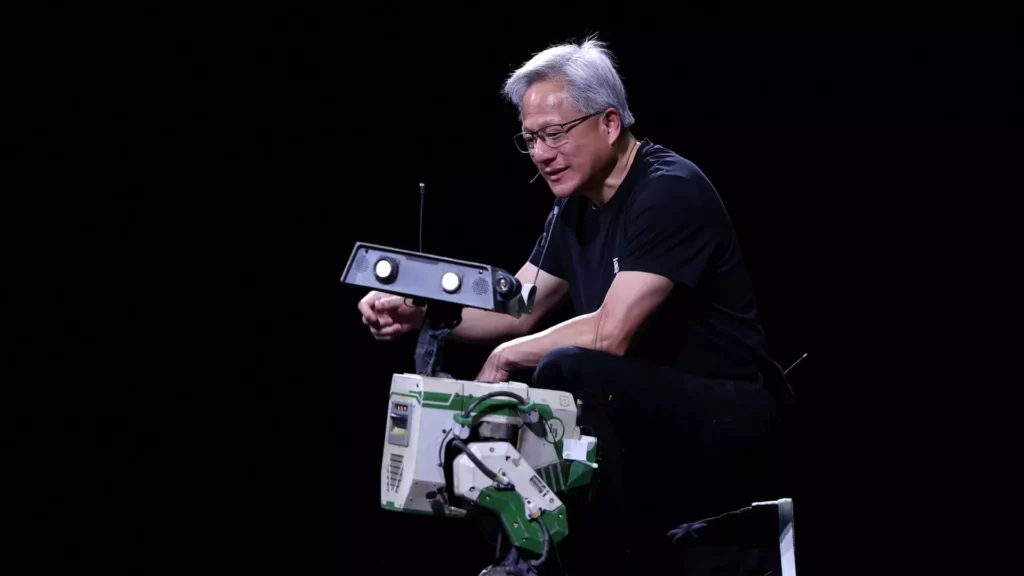In the chaotic whirlwind of technological advancement, few companies have managed to forge a path quite like Nvidia. As a powerhouse in the semiconductor industry, Nvidia is not simply riding the waves of popular trends in artificial intelligence (AI) and robotics; it is redefining them. Recent declarations from CEO Jensen Huang highlight an ambitious vision that extends beyond traditional chip manufacturing. By positioning robotics at the forefront of its growth strategy, Nvidia is setting itself apart from competitors. This isn’t just corporate marketing; it’s a paradigm shift aimed at reshaping entire industries.
What sets this endeavor apart is Nvidia’s recognition of the symbiosis between AI and robotics, particularly within autonomous driving technology. The self-driving car market stands as the tip of the iceberg, serving as a critical entry point for Nvidia into broader robotics applications. Huang’s remarks signal an astute acknowledgment of where the market demand lies and how technological convergence is creating unparalleled growth opportunities. For investors, the implications are profound, as early adoption of these visions paves the way for future capital gains.
Unprecedented Financial Growth
Nvidia’s recent financial impact should not be overlooked. The staggering growth from around $27 billion in turnover for fiscal year 2023 to projected revenues nearing $200 billion this upcoming year is a phenomenon that demands attention. It is fueled largely by a skyrocketing demand for data center graphics processing units (GPUs), which form the backbone of complex AI applications, including OpenAI’s revolutionary ChatGPT. Such figures are often relegated to mere statistics in the business world, but they reveal the fruits of strategic foresight; this is where Nvidia becomes a harbinger of technological renaissance.
The fact that Nvidia’s stock price has reached record highs—catapulting its market capitalization to an astonishing $3.75 trillion—sheds light on investor confidence in its trajectory. The company’s lead over tech titans, including Microsoft, underscores its dominance in this high-stakes game of innovation. Nvidia’s remarkable financial performance is indicative not just of sales across products but of its stature as a transformative force in the tech industry.
Shaping the Future of Robotics
Nvidia is not just a passive player in the influx of autonomous vehicles and intelligent machines; it’s an active architect of this brave new world. With initiatives that include the Drive platform powering fleets of self-driving cars, Nvidia is fully immersed in automotive technology’s evolution. Its collaborations with prominent companies like Mercedes-Benz validate the seriousness of its innovations. Huang’s envisioning of a future filled with billions of robotic entities is no longer relegated to speculative science fiction; it is a firm, actionable plan underpinned by robust technological capabilities.
The introduction of specialized AI models for humanoid robots highlights Nvidia’s commitment to pushing the boundaries of what is possible. They are not merely following trends; they are establishing them, thereby ensuring that they are not left behind in this fast-evolving landscape. It’s this sort of thinking that positions Nvidia as a proactive entity, eager to rework the conventions of an industry rather than adhering to stagnant norms.
A Transformative Market Identity
Huang’s strategic rebranding of Nvidia as not just a chip company but an “AI infrastructure” provider illustrates an important turning point for both the company and the market at large. This marked shift reflects a deeper understanding that the future of technology lies not in isolated components but in a holistic ecosystem. By merging software, cloud services, and networking capabilities with powerful hardware, Nvidia is shaping itself into a one-stop solution for everything AI and robotics.
This multifaceted approach addresses the complexities inherent in AI deployments. By simplifying the integration process for developers, Nvidia not only amplifies its competitive standing but also helps prospective rivals understand the uphill battles they may face. In this context, Nvidia is not simply participating in the technology race; it is defining the parameters of engagement itself.
The Call for a Visionary Roadmap
Ultimately, Nvidia stands as a testament to what a forward-thinking company can achieve when it aligns innovative capabilities with market needs. Huang’s continued ambition places Nvidia miles ahead of the competition and paves the way for the future of self-driving vehicles and automated solutions. As these technologies become more entwined in our daily lives, it’s clear that Nvidia’s footprint will be all but inescapable. The potential rewards for investors are enticing, but it’s the broader implications for humanity, intertwined with efficiency and advancement, that truly underscore Nvidia’s transformative vision.









Leave a Reply